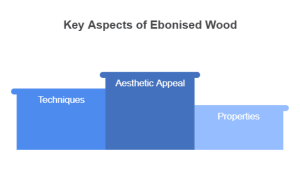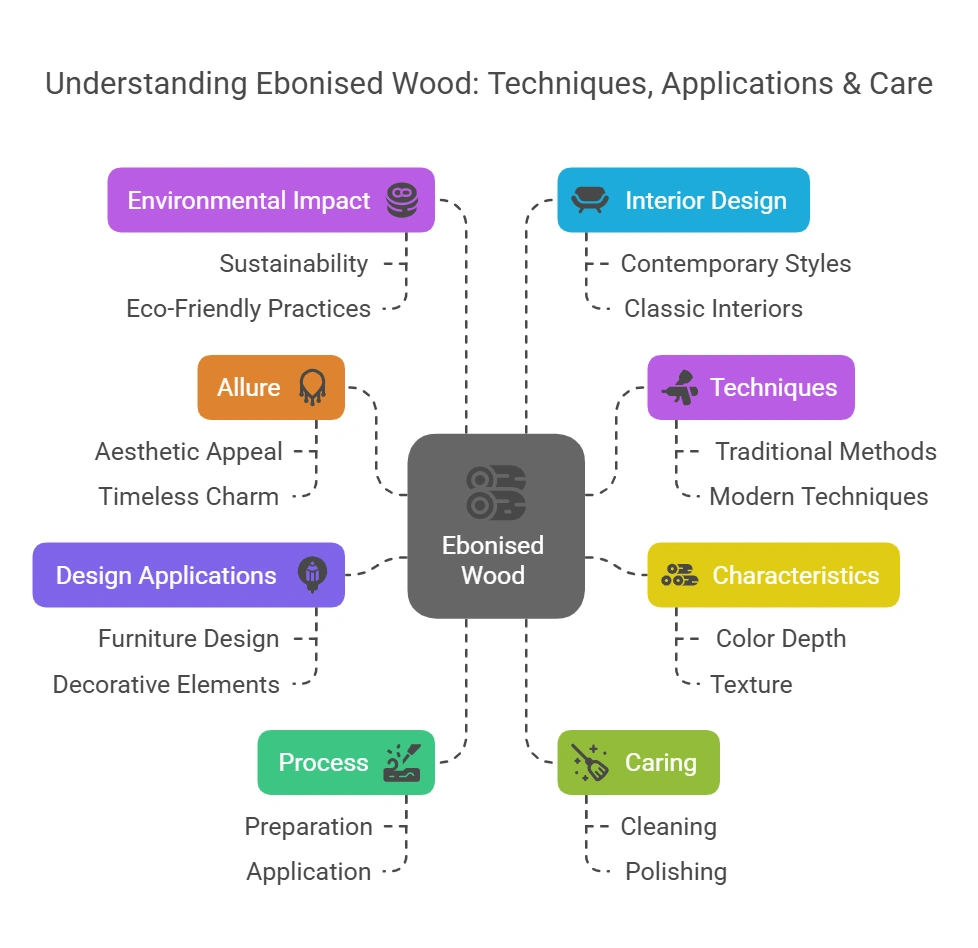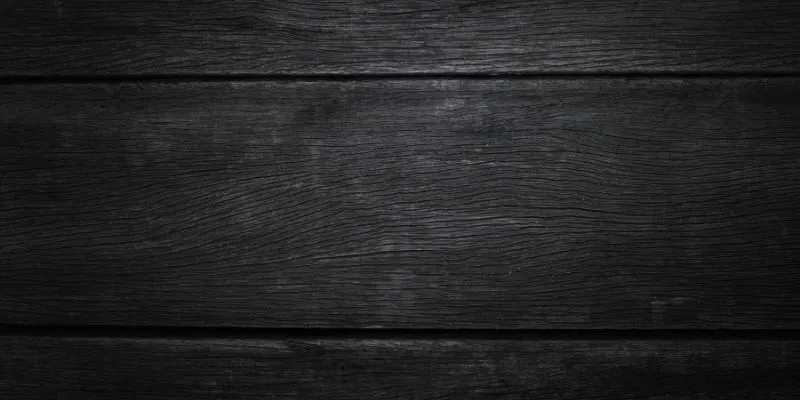Ebonised wood is timber that has been treated to achieve a dark, rich finish, resembling ebony. This process enhances the wood’s appearance while preserving its natural characteristics.
Ebonised wood has gained popularity for its elegant, sophisticated look. Often used in furniture and cabinetry, this finish offers a striking contrast against lighter materials. Artisans achieve the ebonised effect through various methods, including staining and dyeing. The process not only enhances the wood’s aesthetic appeal but also highlights its grain patterns.
Ebonised wood is commonly made from species like oak or pine, providing durability and versatility. Homeowners and designers appreciate its timeless charm, making it a favored choice in modern and traditional interiors alike. Embracing ebonised wood can elevate any space with a touch of luxury.
The Allure Of Ebonised Wood
Ebonised wood is created by treating lighter woods to mimic the look of natural ebony. This process gives the wood a rich, dark finish. Ebonisation has its roots in the 19th century. Craftsmen sought to replicate the beauty of ebony, which was rare and expensive.
Natural ebony is a dense, dark wood from various trees. It is known for its luxury appeal and durability. Ebonised wood, on the other hand, is more affordable and accessible. This makes it popular for furniture and decor.
| Feature | Ebonised Wood | Natural Ebony |
|---|---|---|
| Cost | Lower | Higher |
| Durability | Moderate | High |
| Appearance | Dark finish | Rich black |
Ebonising Techniques Explored
Ebonised wood is a popular choice for its rich, dark finish. Traditional methods often use natural dyes. These dyes can come from sources like walnut husks or charcoal. Craftsmanship plays a key role in achieving the desired look.
Modern advances utilize chemical treatments for quicker results. These treatments ensure a consistent color across various wood types. Some techniques even enhance the wood grain, adding depth and character. Safety precautions are crucial when using chemicals.

Characteristics Of Ebonised Wood
Ebonised wood is known for its rich, dark color. This wood comes from various species, often dyed to enhance its appearance. The texture is usually smoother than natural wood. Ebonised wood offers a striking look for furniture and decor.
Its durability makes it suitable for many uses. This wood is resistant to wear and tear. Regular maintenance is essential to keep it looking good. Use a soft cloth for cleaning to avoid scratches.
Applying a good quality wood polish helps maintain its shine. Avoid harsh chemicals that can damage the finish. Ebonised wood can last for many years with proper care.
Design Applications
Ebonised wood is a popular choice for furniture and cabinetry. It adds a sleek, modern look to any space. This wood type has a deep, rich color that enhances its beauty. Designers often use it for tables, chairs, and cabinets.
Architectural elements benefit greatly from ebonised wood. It can be used for doors, trim, and moldings. This wood creates a striking contrast with lighter colors. It helps to achieve a sophisticated and elegant atmosphere in homes and offices.

The Process Of Ebonising Wood
Ebonising wood gives a rich, dark finish. This process starts with preparing the wood. First, the wood must be clean and smooth. Any dirt or old finish should be removed. Sanding helps to achieve a nice surface.
Next, an ebonising solution is applied. This solution usually contains iron and vinegar. The wood absorbs this mixture, turning it darker. Applying multiple coats can deepen the color. Let the wood dry completely between coats.
After the final coat, a sealant is often used. This protects the wood and enhances its beauty. The result is a stunning, deep black wood that looks elegant.
Caring For Ebonised Wood
Caring for Ebonised Wood helps maintain its beauty and longevity. Regular cleaning is essential. Use a soft, damp cloth to wipe the surface. Avoid harsh chemicals or abrasive materials. They can damage the finish.
For stubborn stains, mix mild soap with water. Gently scrub the area with a soft sponge. Rinse the sponge and wipe off any soap residue. Allow the wood to dry completely.
| Restoration Technique | Description |
|---|---|
| Re-oiling | Apply a suitable oil to enhance color and shine. |
| Light sanding | Use fine-grit sandpaper to remove scratches. |
| Refinishing | Strip old finish and apply a new coat for a fresh look. |
Environmental Impact And Sustainability
Ebonised wood is popular for its striking appearance and durability. Sourcing responsibly is key to protect our forests. Many companies use sustainable practices to obtain this wood.
Some methods include:
- Replanting trees after harvesting.
- Using wood from well-managed forests.
- Supporting local communities.
Eco-friendly alternatives exist for those seeking options. Bamboo is a strong and renewable choice. Reclaimed wood offers a unique look while reducing waste.
These options help preserve nature while still enjoying beautiful furniture and designs.
Ebonised Wood In Interior Design
Ebonised wood is a popular choice in modern decor. It adds a touch of elegance and sophistication. This wood looks sleek and fits well with various styles. Dark finishes bring out the beauty of furniture and fixtures.
In historical interiors, ebonised wood has rich significance. It was often used in Victorian and Art Deco designs. This wood symbolizes luxury and craftsmanship. Many antique pieces feature ebonised wood, showcasing its timeless appeal.

Frequently Asked Questions
What Is Ebonised Wood Made From?
Ebonised wood is typically created from lighter woods like pine or maple. The process involves applying a stain or dye that mimics the rich black color of true ebony. This technique allows for a cost-effective alternative to solid ebony while maintaining a similar aesthetic appeal.
How Is Ebonised Wood Treated?
Ebonised wood is treated using a combination of stains, dyes, and finishes. These treatments enhance the wood’s appearance and protect it from damage. The most common methods include using chemical stains or vinegar and steel wool solutions to achieve that deep black color.
What Are The Benefits Of Ebonised Wood?
Ebonised wood offers several benefits, including a striking appearance and affordability compared to solid ebony. It is versatile, fitting various design styles. Additionally, it provides durability and resistance to wear, making it suitable for furniture and decorative applications.
Is Ebonised Wood Durable?
Yes, ebonised wood is quite durable when properly treated. The finishing processes used enhance its resistance to scratches and moisture. However, care is still necessary to maintain its appearance over time, especially in high-traffic areas or outdoor settings.
Conclusion
Ebonised wood offers a unique aesthetic and durability for various applications. Its deep, rich color enhances the beauty of furniture and decor. Understanding its characteristics can help you make informed choices for your projects. Embrace the elegance of ebonised wood to elevate your space and enjoy its timeless appeal.

